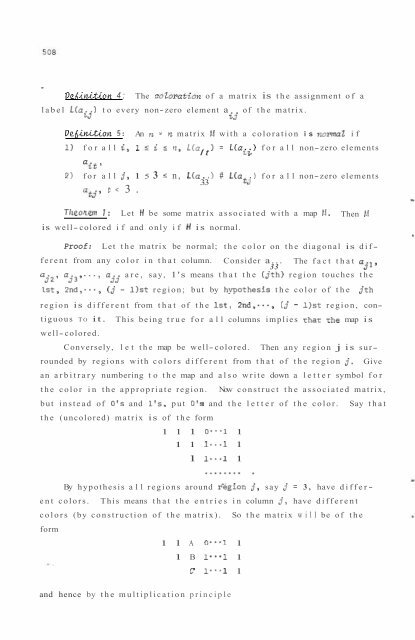Create successful ePaper yourself
Turn your PDF publications into a flip-book with our unique Google optimized e-Paper software.
Oe;(i&on 4: The cohati.on of a matrix is the assignment of alabel L(a..) to every non-zero element a of the matrix.t'jMVedin&ion 5: An n x n matrix iM with a coloration is iwrrnaz if1) for all i, 1 5i 5 n, L(a. } = L(a..) for all non-zero elementsIt It"it '2) for all j, 1 5 3 < n, L(a . .) # Ua ) for all non-zero elements33 tiat., t< 3.Theohem 1 : Let H be some matrix associated with a map M. Then f.1is well-colored if and only if H is normal.Proof: Let the matrix be normal; the color on the diagonal is dif-ferent from any color in that column.Consider a... The fact that ail,33a3, aj, ..., ajj are, say, 1's means that the (jth) region touches theIst, 2nd,---, (j - 1)st region; but by hypothesis the color of the jthregion is different from that of the lst, 2nd,--., (j - l)st region, con-tiguous TO it. This being true for all columns implies rha~ rhe map iswell-colored.Conversely, let the map be well-colored.Then any region j is sur-rounded by regions with colors different from that of the region j. Givean arbitrary numbering to the map and also write down a letter symbol forthe color in the appropriate region.<strong>No</strong>w construct the associated matrix,but instead of 0's and l's, put 0's and the letter of the color.the (uncolored) matrix is of the form1 1 1 0-0.1 11 1 1 - e . 1 11 1--.1 1Say thatBy hypothesis all regions around r'egion 3, say J' = 3, have differ-ent colors.This means that the entries in column j, have differentcolors (by construction of the matrix).form1 1 A 0---1 11 B 1."1 1C 1---11and hence by the multiplication principleSo the matrix will be of theA A A 0"'A AB B B"-Bc C---Cand it is normal (the argument above being true for all columns).A question of considerable importance is if the map is well-coloredwith the minimum possible number of colors.BcObviously, normality doesnot imply that the map is well-colored with the minimum number of colors;the converse Is however true.In order to well-color with minimum numberof colors, every time we get to a new row we must investigate to see ifwe can use again colors already used..Sometimes we will have a choiceof two colors (already used) leading to a different number of total colorsused. In any case the matrix will be normal. Example:A A O O A A A 0 0 AB O B S B O B BA A A B B Bc C A APc(4 colors needed) (3 colors needed)This does not present a problem, however, since In application of thisprocedure to the four color problem we suppose there exists a matrix withn + 1 columns, representing the smallest map h!in E? requiring five colors.If we can fuse together two regions in such a way that the resulting n x nmatrix (map) still requires 5 colors, we achieve a contradiction sinceII was the smallest such map; hence no such map could exist.we already know that n has to exceed 40.Of course,See Ore and Stemple [?I. Tothat end we present (without proof) the following theorem.Theohem 2: Let ?.I be a map, /f its matrix. Let R , R t"S two con-tiguous regions (Le. a = 1) and assume j > a. Let A!' be a map iden-CVrical with 1.1 except that the regions R and R are combined. Let H' be a3a matrix obtained as follows:1) "Add" the corresponding entries of row j In H to row a in H asfollows: 1 + 0 = 0 + 1 = 1, 0 + 0 = 0, 1 + 1 = 1.2) "Fold" the J'th column at entry a+ Then:a) "Add" (as above) the corresponding elements of the unfoldedpart to the entries of the a columns
















